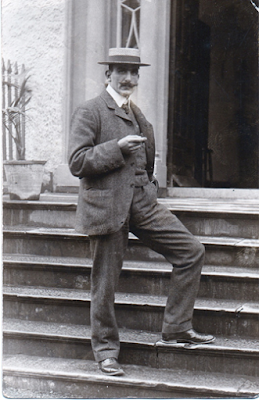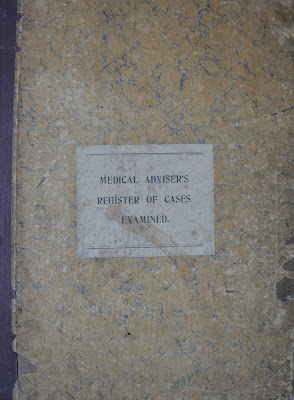The papers of Neil John Blayney, a physician based at the Queen’s County Infirmary in the early 20th century, are not extensive. They feature receipts, letters, some medical records and ephemera related to his short life and career. The collection was donated to the Royal College of Physicians in Dublin, and my job as a trainee archivist was to ‘process’ the collection. This involved arranging the material (which had been received with no obvious original order) into logical groups called ‘series’, providing brief descriptions for the items within, and presenting this as a catalogue to aid researchers in using the collection. All straightforward so far, right?
Despite its status as a relatively small collection however, throughout my experience of processing a quote from the writer W. G. Sebald kept coming to mind - “Tiny details imperceptible to us decide everything!”[1] . The ‘box list’ – a preliminary ‘survey’ list of the collection - compiled in the first stages of processing revealed hints of these tiny details. Mentions of a job application in correspondence, with no follow up information. A permission slip to drive into Dublin City on one of the most crucial days of the Easter Rising. Medical records of soldiers, lay people and even Blayney’s loved ones. This collection, although small in size, was full of tiny details that decided everything.
 |
| Dr Neil John Blayney |
The items that illustrated this to the greatest extent were the medical records kept by Blayney and I found myself seeing parallels between his role as a County Surgeon and that of an archivist. Like my box list, these medical records kept the core details - the metadata - that signified entire lives. They summarised years of Blayney’s decisions as a doctor in the way that the box list summarises a collection for the archivist. They were full of tiny details, imperceptible to me, that decided the lives of Neil John Blayney’s patients.
As my processing of the collection progressed, I was faced with the decision of where to include these medical records in the catalogue. As mentioned, the collection had no original order and I had arranged it thus far into the following series: ‘Medical Training and Career’, ‘Finances and Personal Effects’ and ‘Other Correspondence’. Initially, I included the medical records, comprising one bound Register of Consultations and two patient record notebooks, within the ‘Medical Training and Career’ series - they were, after all, the output of Blayney’s work.
However, as I further considered the arrangement and description of the collection, I felt increasingly uncertain that the medical records really belonged here. To me, the medical records were not representative of a line on Neil John Blayney’s CV. They signified a wider profession delivered in a specific context. They were a box list (of sorts) of lived lives and recorded the experience of a medical professional confronted with soldiers, rampant influenza, tuberculosis, the long-term suffering caused by malaria, and requests for compassionate leave.
Ultimately, I opted to create an additional series ‘Medical Records’ which would encompass both those records kept by Neil John Blayney, but also allowed for inclusion of additional medical records within the collection that had been kept for Mrs. Blayney during a stay in the Mater Misericordiae. In this way, the series which included information pertaining to the training and roles held by Blayney was complimented by a series that documented the lived experience of those roles.
Having determined my arrangement, I turned my thoughts toward the descriptions for the items within the ‘Medical Records’ series. Yet once again, what seemed like a straightforward task revealed itself, in the detail, to be more complicated. The item ‘Register of Consultations’ not only contained patient records from 1913-1914, but also a span of patients’ payments covering a range of years. Aside from revealing that Neil John Blayney might not have managed filing in the most coherent way possible, I could see that even at the level of description, processing an archival collection is not clear cut. It is not about ‘giving an answer’. All the archivist can do is make decisions around description that promote reliability, authenticity, and accessibility. In the case of this item, and the other records within this series, I opted to provide a brief description that I knew to be true, acknowledging that it would not be possible or appropriate to describe in detail the patients within.
 |
| Medical Adviser's Register of Cases Examined (NJB/4/1) |
Processing an archival collection has been referred to as “a continuum of possible decisions and actions, ranging from minimal to optimal”[2] . This rang true throughout my processing experience, which became less of the administrative task it had initially seemed and more a process of constant refinement. By considering the medical records in this collection at a slight remove from the career of Neil John Blayney, and through understanding the possibilities (and limitations) of description, I could create a series that logically completed others within the collection.
It did not escape my notice that within the ‘Register of Consultations’, a heading was created for records until March 1919 - a date that Neil John Blayney did not live to see. For the County Surgeon, the archivist, and the individual, sometimes the greatest life events are in the silence - in the tiny imperceptible details that decide everything.